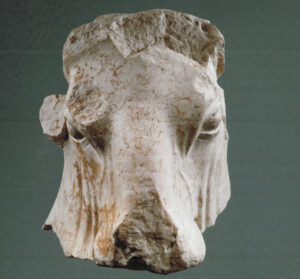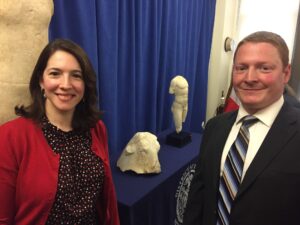Ownership Dispute of Lebanese Antiquity at the Met
Note: All of the information in this blog post is taken from a publicly filed document. No confidential or privileged information was used in preparing this post.
 On September 22, Matthew Bogdanos submitted an application in NY Supreme Court in a matter involving a stolen antiquity from Lebanon. Our founder served as a cultural heritage law expert on this case. It was an honor to once again work with Bogdanos, a talented trial attorney. His track record for excellence is impressive, and the filing in this case is a tour de force of legal writing, reading like a suspenseful crime narrative and primer on cultural heritage law. The document was full of famous art world names, citations to landmark cases and conventions, and introduction to the world of art crime and heritage looting.
On September 22, Matthew Bogdanos submitted an application in NY Supreme Court in a matter involving a stolen antiquity from Lebanon. Our founder served as a cultural heritage law expert on this case. It was an honor to once again work with Bogdanos, a talented trial attorney. His track record for excellence is impressive, and the filing in this case is a tour de force of legal writing, reading like a suspenseful crime narrative and primer on cultural heritage law. The document was full of famous art world names, citations to landmark cases and conventions, and introduction to the world of art crime and heritage looting.
The cast of characters involved in this matter have become household names in the heritage field. The Aboutaams (owners of Phoenix Ancient Art) have been involved in numerous legal battles; Robin Symes, described as a “disgraced” art dealer, has been connected to dozens of pillaged antiquities; Frederick Schultz (former New York gallery owner and former president of the National Association of Dealers in Ancient, Oriental and Primitive Art) served time for dealing in looted Egyptian antiquities; Michael Steinhardt, founder of a hedge fund and referred to as “Wall Street’s Greatest Trader,” has faced many legal controversies for his art collection (including this year’s disputed sale of the Guennol Stargazer at Christie’s); and Frieda Tchacos, a dealer with a history of antiquities violations has been profiled for her role in the illicit antiquities trade. All of these individuals have been featured in books like Chasing Aphrodite and the Medici Conspiracy. In fact, the dispute over the Bull’s Head reads like a redux of the Euphronios Krater debacle at the Metropolitan Museum of Art (“the Met”). However, as Bogdanos notes in the government’s filing, the Met acted “admirably” by removing the item from display and delving into the object’s past.
The current controversy involves an antiquity that was purportedly looted from storage in Lebanon during the nation’s civil war. It went missing for decades and then appeared at the Met after it was loaned to the museum by Michael Steinhardt. He had purchased the item from wealthy collectors, Will and Lynda Beierwaltes. Once Steinhardt was informed of the work’s problematic provenance, he demanded a refund for the purchase and transferred title to the object back to the couple.
One of the most interesting aspects of this case is Bogdanos’ discussion about “good faith.” The Beierwaltes are not novice collectors; they owned a collection of antiquities valued at nearly $100 million. As “professional” collectors, did they really use good faith in acquiring the antiquity? As Bogdanos rightly asks: where are the documents related to the object? If an antiquity of such high value (over a million dollars) crosses international borders multiple times, there should be documentation that traces its movements.
“There is no customs declaration form, no shipping document, no air waybill, no tracking form, no insurance form, no invoice, no bill of sale, no photograph, and no mention in any contemporaneous correspondence or email. No proof of any kind of the possession and repeated transportation across oceans and international borders of a two-millennia-old statue valued at more than one million dollars by either of the names listed by the Met on October 20, 2017.” As stated on page 45, “…twenty-four years (1981-2004) of movement across international borders of a million-dollar statue generated four handwritten words, a couple storage invoices, and one piece of paper from the infamous Robin Symes. A neon sign flashing ‘stolen’ would have been more subtle and less insidious.”
One of the disturbing aspects of this controversy is the allegation that the sculpture was taken during the civil war in Lebanon. If true, then the item was pilfered by opportunists taking advantage of political upheaval to steal priceless and irreplaceable treasures. Sadly, this type of theft occurs around the world and is still common today, particularly prevalent in Syria and Iraq.
Purchasing items without complete provenance is risky. As I explained in this editorial in The Guardian, looted antiquities are problematic from an investment perspective. Bogdanos warns against this risk, stating “The obvious, but all-too-often ignored, risks attendant to never asking about ownership history is that the buyer may one day have that purchase seized and confiscated as stolen property. Here, the absence of the required inquiry, not only subjects the Beierwaltes to potential prosecution for criminal possession of stolen property, but it also defeats any claim that they were good-faith purchasers of the Bull’s Head.”
As outlined in the government’s conclusion, there are a host of important facts to recognize in this case. (1) The Bull’s Head was excavated in 1967 and stolen in 1981 during a civil war, nearly 50 years after Lebanon’s patrimony laws (the laws vest ownership of all discovered antiquities in the nation). (2) The sculpture surfaced in the hands of Robin Symes in NY in early 1996. As revealed by several international investigations, Symes was a major participant in an antiquities trafficking network in the 1980s and 1990s. The network’s black-market supply chain started with tomb raiders, passed through the launderers and middle men, and terminated at the demand end with collectors, like the Beierwaltes. (3) The Symes-Beierwaltes relationship was responsible for 98% of the vast Beierwaltes Collection, valued at almost $100 million in 2006. The acquisition of the collection appears to have coincided with the peak of the Medici, Becchina, and Symes empire of loot. (4) There is a shocking lack of documentation produced by the Beierwaltes. (5) The lack of records is especially telling for collectors involved in the art trade for 62 years. (6) The Beierwaltes avoided submission of any materials pursuant to discovery requests, despite multiple subpoenas and repeated requests. There is also no evidence concerning how Robin Symes acquired the Bull’s Head or whether he legally possessed it. (7) Lebanon made commendable efforts to protect and to recover its cultural heritage.
A copy of the the government’s filing can be found on the Chasing Aphrodite website: https://chasingaphrodite.com/2017/09/24/the-sidon-bulls-head-court-record-documents-a-journey-through-the-illicit-antiquities-trade/

Our founder at the repatriation ceremony in 2017
UPDATE: The Bull’s Head (as well as two other pieces) were returned to Lebanon in December 2017.